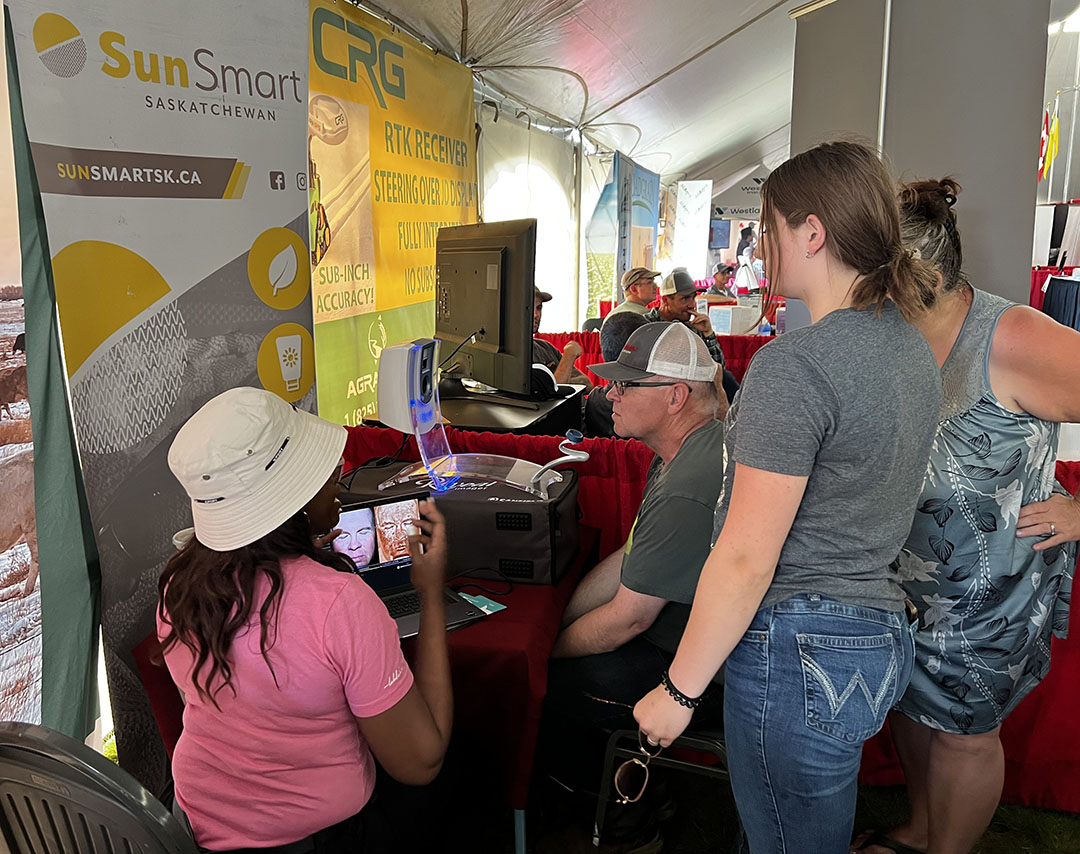
Sun safety in agriculture: USask partnership at Ag in Motion
High temperatures move the sun from a welcome summer friend into enemy territory, with high UV exposure and extreme heat warnings. Last week’s outdoor agricultural show, Ag in Motion, near Langham, Sask., saw three days of intense heat July 16-18.
By CCRAH communicationsLangham, Sask., saw three days of intense heat July 16-18.
That heat made Ag in Motion the perfect place to showcase the importance of helping farmers manage relentless heat and sunshine.
Registered nurse Kendra Ulmer of the Canadian Centre for Rural and Agricultural Health (CCRAH) at the University of Saskatchewan (USask) said that outdoor farm and ranch work may put farmers and ranchers at a higher risk of UV radiation exposure, which could lead to increased risk of skin cancer.
“Our Ag in Motion booth was busy. The heat and sunshine really gave us the perfect backdrop to showcase our working partnership with Sun Smart Saskatchewan, focusing on sun safety in agriculture,” Ulmer explained.
There are more than 4,000 cases of skin cancer diagnosed in Saskatchewan every year, including over 300 cases of melanoma, the most serious skin cancer.

Ulmer is the manager of the Agricultural Health and Safety Network (AHSN) at the CCRAH. The motto of the AHSN is ‘Stronger together in agricultural health and safety.’ That motto drives action with research and outreach partnerships, such as with Sun Smart Saskatchewan.
Sun Smart Saskatchewan is a coalition of groups committed to skin cancer prevention, including the Saskatchewan Cancer Agency and the Canadian Cancer Society. Its partnership with AHSN involves sharing resources such as printed information and sun safe swag, working together on projects, and sharing booth space during outreach events such as Ag in Motion.
The network has also recently added a sun safety teaching module to the AHSN Discovery Days program, which offers hands-on farm safety education for rural kids in Grades 4-6. Sun Smart Saskatchewan provides UV bracelets and take-home resources for the Discovery Days program.
At the Ag in Motion booth, farm families picked up printed information about UV radiation and risks, and reminders of good practices to follow when going out in the sun. These practices include slipping on long-sleeved clothing, slapping on a good wide-brimmed hat, slopping on sunscreen (minimum SPF 30), seeking shade, and sliding on sunglasses of UV400 protection.
There were take-home resources at the booth, including bucket hats, sunscreen, UV400 sunglasses, and UV bead bracelets, to remind everyone to pay attention to sun protection.
“We ran out of hats by the end of the second day, which is good, because it was really hot and sunny. We saw people wearing their hats, which is what we want,” Ulmer added.

Visitors also received an in-the-moment assessment and screening of UV radiation damage to their skin. Marion Waysome-McIntyre, population health promotion practitioner with the Saskatchewan Cancer Agency, was on hand with the agency’s Reveal Imager (facial camera) which allowed farmers to see the impacts of the sun on their face and ears.
The special camera takes a picture of the face, then runs diagnostic analysis of the underlying UV damage, creating a picture that becomes a useful screening tool. Waysome-McIntyre used the image to discuss what’s happening to the skin, and how to best prevent further damage.
Dr. Shelley Kirychuk (PhD), director of CCRAH said that the Ag in Motion booth and larger partnership with Sun Smart Saskatchewan show the centre’s key to success.
“Partnerships with groups like Sun Smart Saskatchewan and the Saskatchewan Cancer Agency are our ‘stronger together’ motto in action,” she said.
“Our centre moves research evidence into programming and services for agricultural people through our AHSN. Ag in Motion draws people from Saskatchewan and beyond and is a great place to work with our partners to showcase safety and injury prevention in agriculture,” she added.
Together, we will undertake the research the world needs. We invite you to join by supporting critical research at USask.

